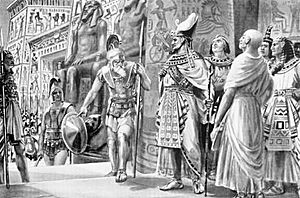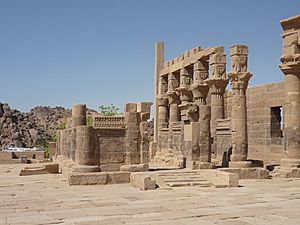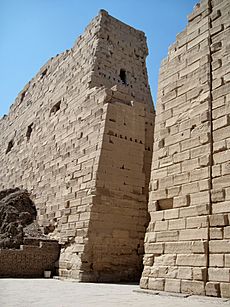Nectanebo I facts for kids
Quick facts for kids Nectanebo I |
|
|---|---|

Statue of Nectanebo I with khepresh crown
|
|
| Pharaoh | |
| Reign | 379/8–361/0 BCE (30th Dynasty) |
| Predecessor | Nepherites II (29th Dynasty) |
| Successor | Teos |
| Children | Teos, Tjahapimu |
| Father | Djedhor |
| Mother | unknown |
Nectanebo I was an ancient Egyptian pharaoh who ruled from 379/8 to 361/0 BCE. He was the founder of the 30th Dynasty, which was the last native Egyptian dynasty to rule Egypt. His Egyptian name, Nḫt-nb.f, meant 'the strong one of his lord'.
Contents
Understanding Nectanebo's Name
Nectanebo's original Egyptian name was Nḫt-nb.f. This name meant "the strong one of his lord." When the ancient Greeks wrote about him, they called him Nectanebis. It's important to know that Nectanebo I had a different name from his grandson, Nectanebo II, even though they sound similar in English.
Nectanebo's Time as Pharaoh
How Nectanebo Became King
Nectanebo I started out as an army general from a city called Sebennytos. His father, Djedhor, was also an important military officer. Nectanebo became pharaoh around 379/8 BCE. He took power by replacing the last pharaoh of the 29th Dynasty, Nepherites II. Some historians believe he might have even put Nepherites II to death.
Nectanebo held his coronation ceremonies in two important cities: Sais and Memphis. He also moved Egypt's capital city from Mendes to his hometown, Sebennytos.
Nectanebo's Family Connections
The exact family connections between Nectanebo and the pharaohs before him are not fully clear. He didn't think highly of Nepherites II or his father, Achoris. He called Nepherites II "inept" (meaning not skilled) and Achoris a "usurper" (someone who takes power illegally).
However, Nectanebo seemed to respect Nepherites I. Some people once thought Nepherites I might have been Nectanebo's father or grandfather. Today, we believe this idea came from a misunderstanding of an ancient text. It's possible that both Achoris and Nectanebo were related to Nepherites I in some way.
Nectanebo had two sons. His older son, Teos, was chosen to rule after him. His other son was named Tjahapimu.
Building and Restoring Egypt
Nectanebo I was a very active builder and restorer of temples. Egypt hadn't seen so much construction work in centuries! He ordered work on many temples all across the country.
One of his major projects was starting the temple of Isis on the sacred island of Philae, near Aswan. This temple later became a very important religious place in ancient Egypt. He also began building the First Pylon (a large gateway) at Karnak.
It's also believed that the earliest known mammisi (a special birth house temple) was built by him at Dendera. Nectanebo also supported the worship of sacred animals. This was a very popular practice during the time between the two Persian occupations of Egypt. Evidence of his support has been found in places like Hermopolis and Mendes. More of his building projects have been found in religious buildings in Memphis, Tanis, and El Kab.
Nectanebo was also very generous to the priests. He issued a special order, found on a stone slab called a stele, in his first year as pharaoh. This order said that 10 percent of all taxes from imports and local goods in the city of Naucratis should go to the temple of Neith in Sais. Another copy of this stele was found in the underwater city of Heracleion. Nectanebo's generosity showed his strong devotion to the gods. It also helped financially support the country's wealthiest people and provided money for Egypt's defense.
Protecting Egypt from Persia
In 374/3 BCE, Nectanebo had to defend Egypt from a Persian attempt to take back control. The Persian king, Artaxerxes II, still saw Egypt as a rebellious part of his empire. After six years of preparation, Artaxerxes sent a huge army. This army was led by the Athenian general Iphicrates and the Persian general Pharnabazus. Records say the army had over 200,000 soldiers, including Persian troops and Greek mercenaries, and about 500 ships.
Nectanebo ordered strong defenses to be built along the Pelusiac branch of the Nile River. This forced the enemy fleet to try to sail up a less protected branch, the Mendesian branch.

At a crucial moment, the two enemy generals, Iphicrates and Pharnabazus, didn't trust each other. This stopped their army from reaching Memphis. Then, the yearly Nile flood began, and the Egyptian defenders fought bravely to protect their land. What looked like a sure defeat for Nectanebo and his troops turned into a complete victory!
After 368 BCE, many western parts of the Persian Empire started to rebel against Artaxerxes II. Nectanebo helped these rebellious regions by giving them money. He also rebuilt strong connections with both Sparta and Athens.
Who Ruled After Nectanebo?
Nectanebo I died during his 19th year as pharaoh. His tomb, his sarcophagus (a stone coffin), and his mummy have never been found. Towards the end of his rule, around 364/3 BCE, Nectanebo brought back an old practice called "co-regency." This meant he made his son, Teos, a co-ruler with him. He probably did this to avoid the problems with who would rule next that had affected earlier pharaohs.
However, shortly after Teos became pharaoh, his brother Tjahapimu betrayed him. Tjahapimu managed to put his own son, Nakhthorheb (who became Nectanebo II), on the Egyptian throne instead.
See also
 In Spanish: Nectanebo I para niños
In Spanish: Nectanebo I para niños



